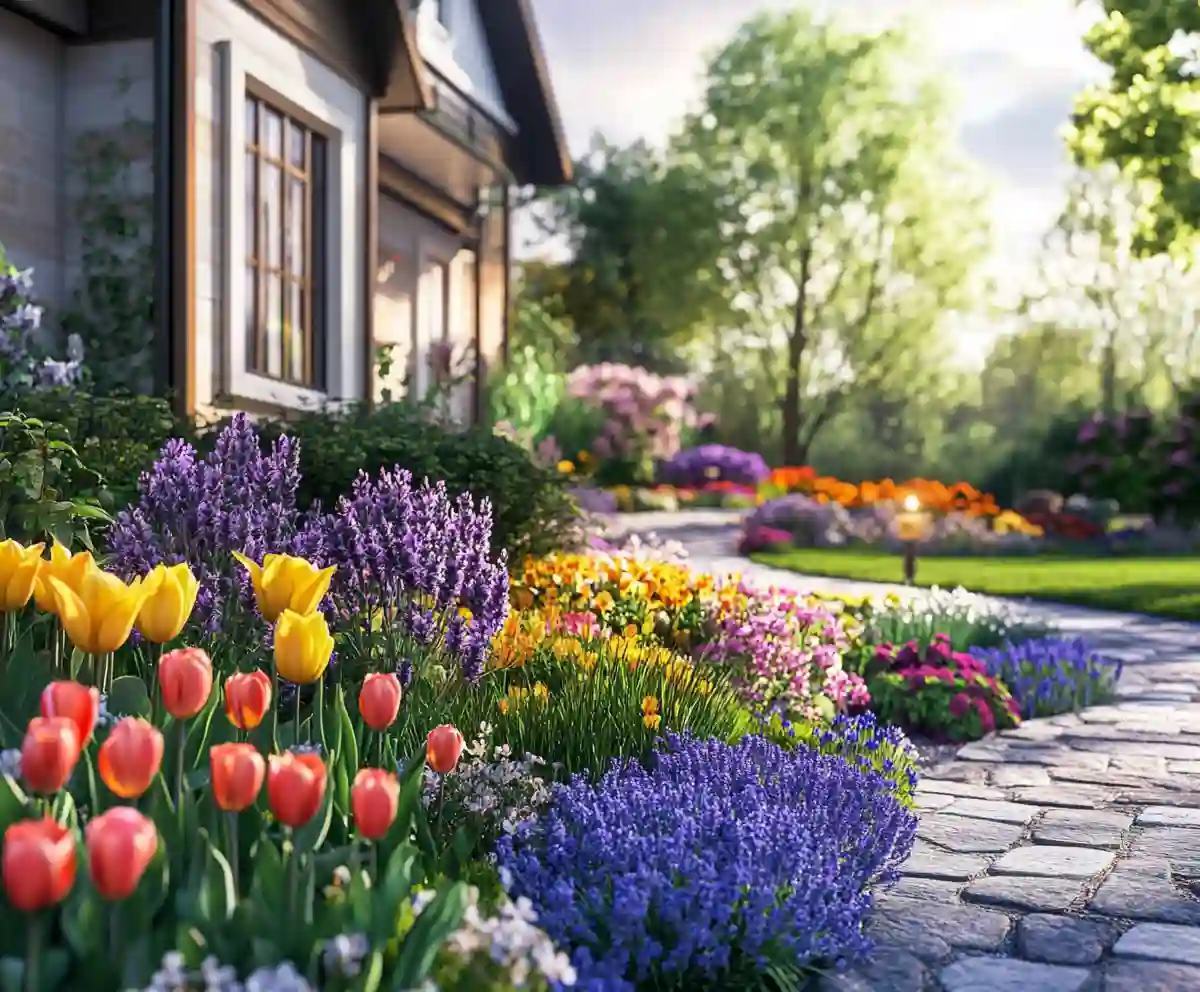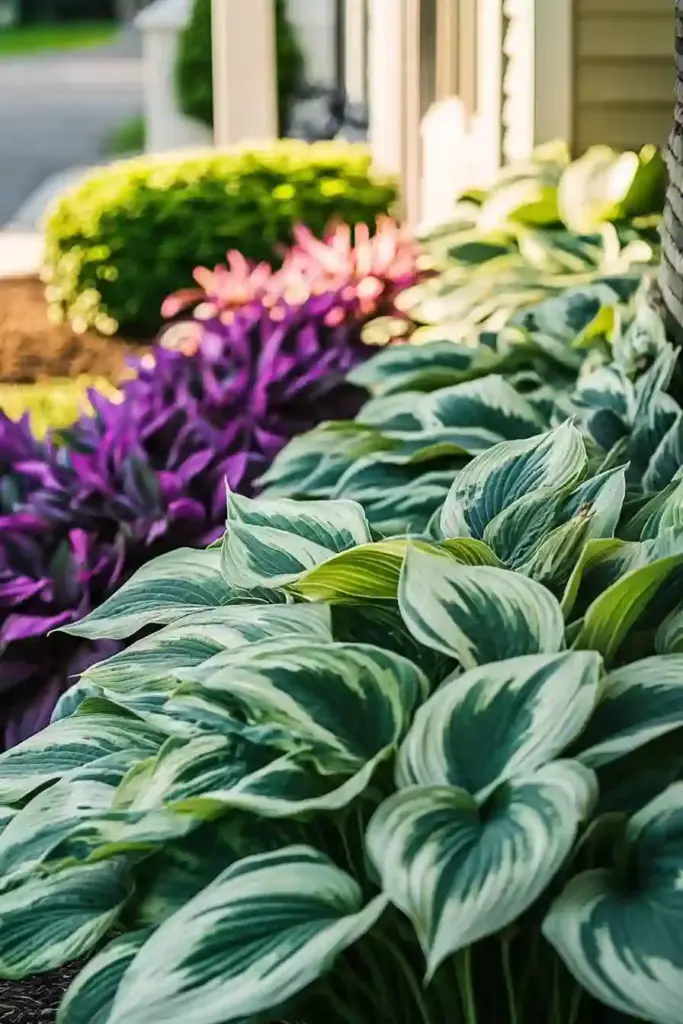Creating flower beds in front of your house is one of the easiest and most rewarding ways to boost your home’s curb appeal. Whether you’re dreaming of a classic cottage vibe or a bold modern entry, the right flower bed can completely transform your space. From color to fragrance and texture, these floral arrangements set the tone for your home and welcome guests with natural charm.
In this guide, we’ll explore the best flowers to plant, how to choose the right ones for your yard, and expert design tips to help your front garden truly bloom.
Let’s dive into the most stunning front yard flower bed ideas, starting with a shade-loving favorite…
1. Hostas: Lush and Low-Maintenance Elegance
If your front yard doesn’t get much sun, hostas might just be your new gardening best friend. These leafy perennials are known for their broad, textured foliage and come in a range of green shades, from silvery blue to deep emerald.
Why Hostas Work Well:
- Thrive in shady areas
- Require minimal upkeep
- Come in dozens of sizes and variegated patterns
- Pair beautifully with ferns, hydrangeas, or astilbe
Planting Tip:
Use taller hosta varieties in the back and shorter ones up front to create a layered, sculpted effect. Add mulch to retain moisture and give the bed a polished finish.
💡 Pro tip: Mixing hostas with other shade-friendly plants adds depth and visual texture. Aim for contrast in leaf size and color for a dynamic design.
2. Daylilies: The Reliable Bloomers for All Seasons
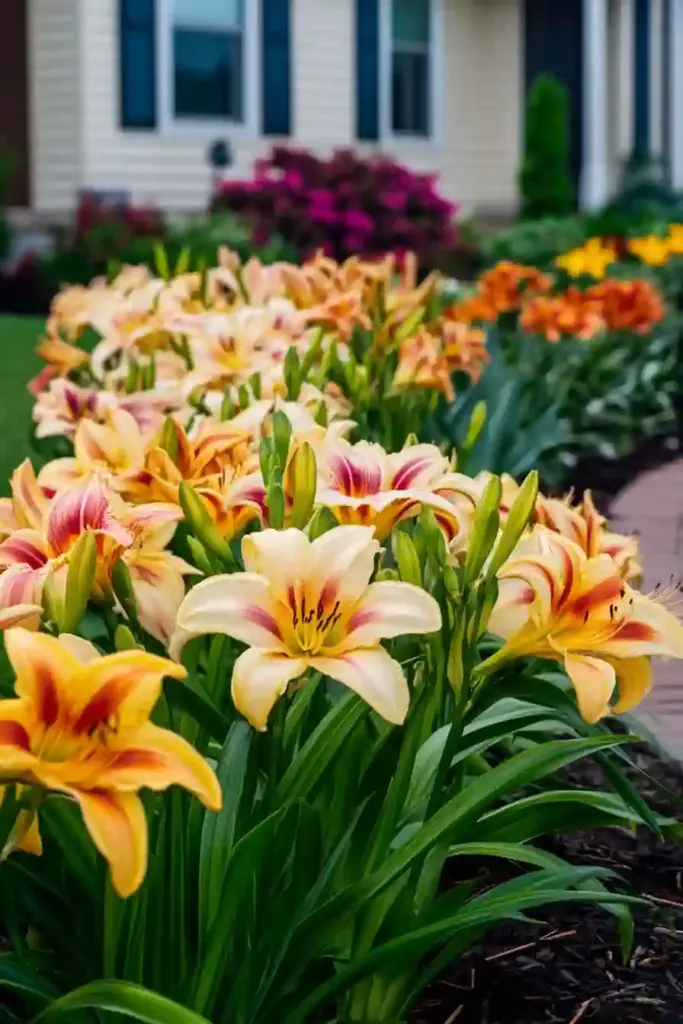
Daylilies are the ultimate crowd-pleasers when it comes to flower beds in front of house designs. With their vivid trumpet-shaped flowers and ability to bloom repeatedly from spring through late summer, these hardy perennials offer long-lasting color with very little effort.
Why Gardeners Love Them:
- Available in an array of colors—from sunny yellows to deep purples
- Low-maintenance and drought-tolerant once established
- Can grow in a variety of soil types
- Great for both formal and casual garden layouts
Planting Tip:
Space daylilies 18–24 inches apart to give them room to spread. Water regularly during dry spells, but don’t worry—these beauties thrive on a little neglect.
💡 For continuous blooms, consider planting early-, mid-, and late-season varieties. You’ll get waves of color all summer long without lifting a finger.
3. Peonies: Timeless Blooms with Big Personality
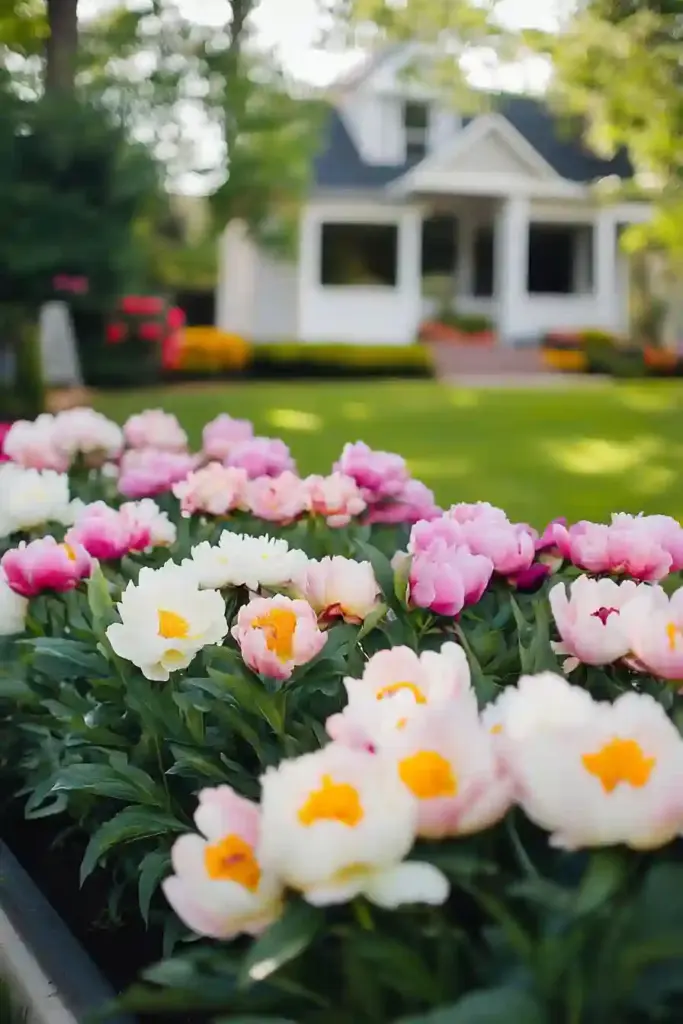
Few flowers make a statement like the luxurious peony. Their large, ruffled blossoms bring elegance and fragrance to any front yard. Blooming in soft pinks, creamy whites, and vibrant reds, peonies create a romantic atmosphere that’s hard to resist.
Why They’re Worth the Wait:
- Perennials that can live for decades
- Stunning cut flowers for bouquets
- Thrive in sunny, well-drained spots
- Combine well with other perennials like irises or salvia
Planting Tip:
Plant peonies in the fall so they can establish strong roots. Avoid planting them too deep—just 1 to 2 inches of soil over the crown is ideal.
💡 Group peonies in odd numbers (3 or 5) for a natural, full look that draws attention without feeling too formal.
4. Hydrangeas: Big Blooms, Bigger Impact

When it comes to dramatic flair, hydrangeas steal the spotlight. Known for their voluminous flower clusters and pastel shades, they can transform any plain front yard into a photo-worthy garden retreat. Their color can even change depending on your soil’s pH—how cool is that?
Why They’re a Front Yard Favorite:
- Stunning seasonal color in blues, pinks, purples, and whites
- Thrive with morning sun and afternoon shade
- Fast growers that fill space beautifully
- Ideal for foundation plantings or statement corners
Planting Tip:
Give hydrangeas about 3–4 feet of space to spread out. They prefer rich, well-draining soil and consistent moisture—especially in their first few years.
💡 To control bloom color, tweak your soil’s pH: acidic soil for blue, alkaline for pink. It’s like flower alchemy for your garden!
5. Lavender: Fragrance Meets Elegance
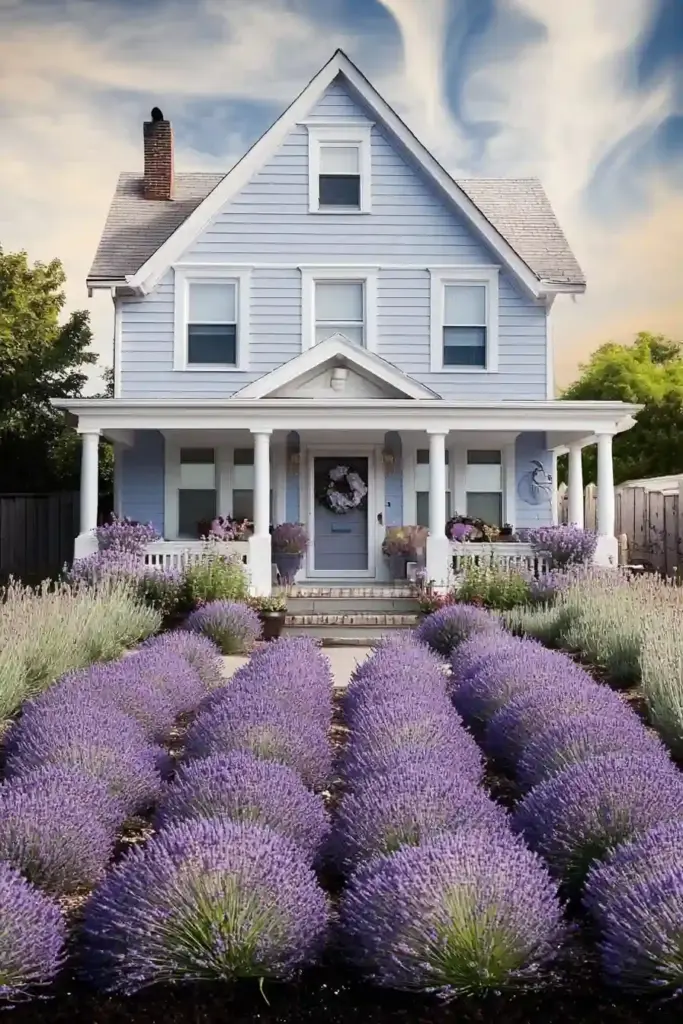
Few plants check all the boxes like lavender. With its soft purple spikes and calming aroma, it brings beauty, scent, and pollinator power to your front flower beds. Plus, it’s incredibly low-maintenance and deer-resistant.
Why Lavender Works Wonders:
- Drought-tolerant and thrives in full sun
- Attracts bees, butterflies, and beneficial insects
- Offers a cottage-garden feel or a sleek, modern look (depending on arrangement)
- Perfect for borders, raised beds, or around walkways
Planting Tip:
Make sure the soil is well-drained and slightly sandy—lavender hates wet feet. Prune in early spring to encourage fresh growth and prevent woodiness.
💡 Use lavender as a fragrant border or plant it near seating areas for a sensory garden experience you’ll enjoy daily.
6. Roses: Classic Charm That Never Fades

No list of flower beds in front of house ideas would be complete without the timeless rose. With hundreds of varieties—from climbers to compact shrubs—you can find a rose to match any garden style.
Why Roses Are Always In:
- Iconic beauty with year-round appeal
- Many are fragrant and repeat-blooming
- Combine well with herbs and annuals for a lush look
- Loved by pollinators and gardeners alike
Planting Tip:
Choose a spot with at least 6 hours of sunlight daily and good airflow. Deep watering once a week is better than frequent light watering, especially in hot climates.
💡 Try pairing roses with lavender or salvia for a stunning mix of texture, fragrance, and color contrast.
7. Tulips: A Springtime Showstopper
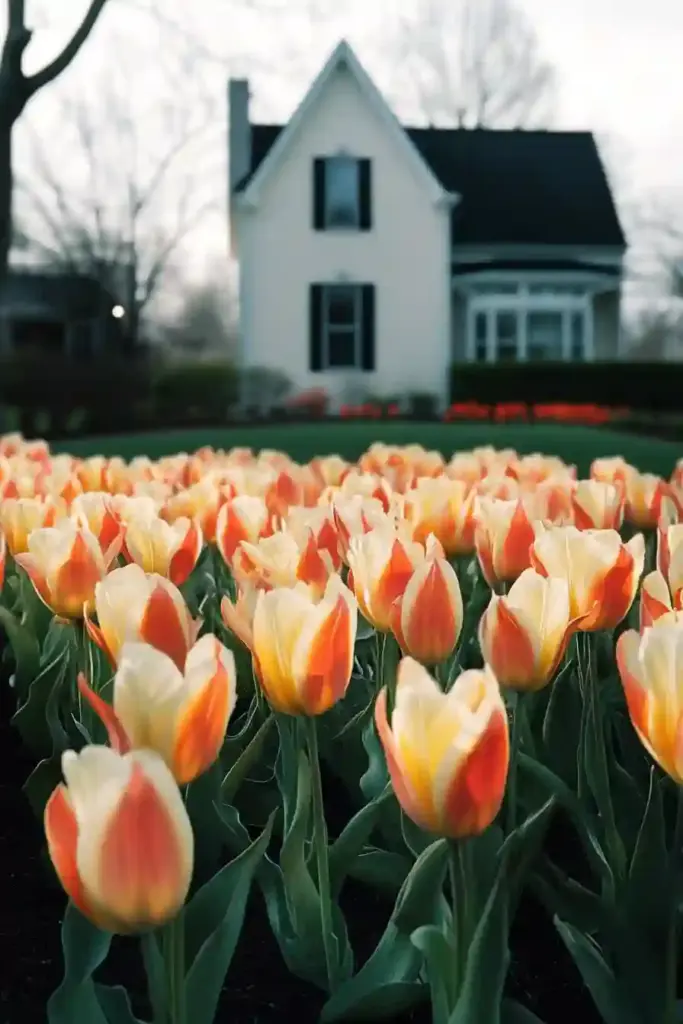
Tulips are like nature’s fireworks—bursting with vibrant color just when your garden needs it most. These spring-blooming bulbs are perfect for adding a bold, cheerful touch to your front yard after the winter chill.
Why Tulips Are a Must:
- Available in nearly every color imaginable
- Bloom early in the season, brightening up your entryway
- Great for planting in clusters or patterns
- Return year after year (with proper care)
Planting Tip:
Plant tulip bulbs in the fall, about 6 inches deep and in groups of five or more for maximum impact. Make sure the spot gets full sun and drains well.
💡 Mix tulip varieties with different bloom times for an extended flowering season. You’ll enjoy color longer with minimal effort.
8. Daffodils: Cheerful and Dependable
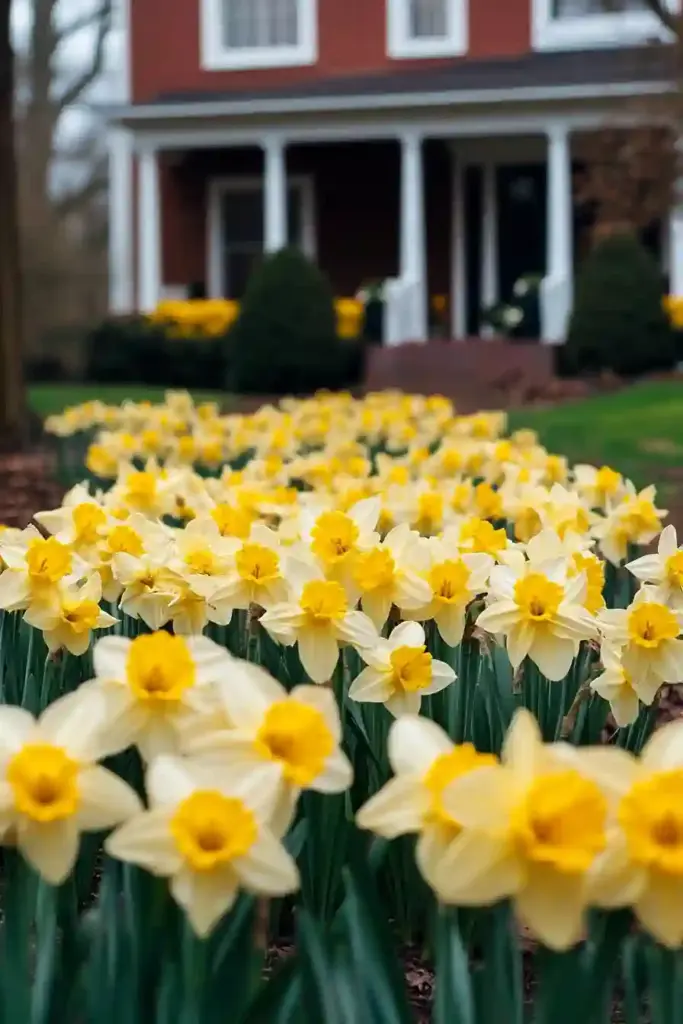
Few flowers bring as much joy as daffodils. With their sunny yellow faces and early-spring blooms, they’re a sure sign that warmer days are ahead. Plus, they’re deer- and rodent-resistant—making them a smart front-yard pick.
Why Daffodils Shine:
- One of the first flowers to bloom each spring
- Multiply year after year with little effort
- Thrive in full sun or partial shade
- Great companion plant for tulips, hyacinths, and pansies
Planting Tip:
Cluster daffodil bulbs in odd numbers for a natural look. Keep the soil well-drained to avoid rot, and don’t cut back foliage until it yellows—this feeds next year’s blooms.
💡 Want a low-maintenance front bed that still pops? Pair daffodils with evergreen shrubs for a year-round display.
9. Lilies: Summer’s Tall and Elegant Stars
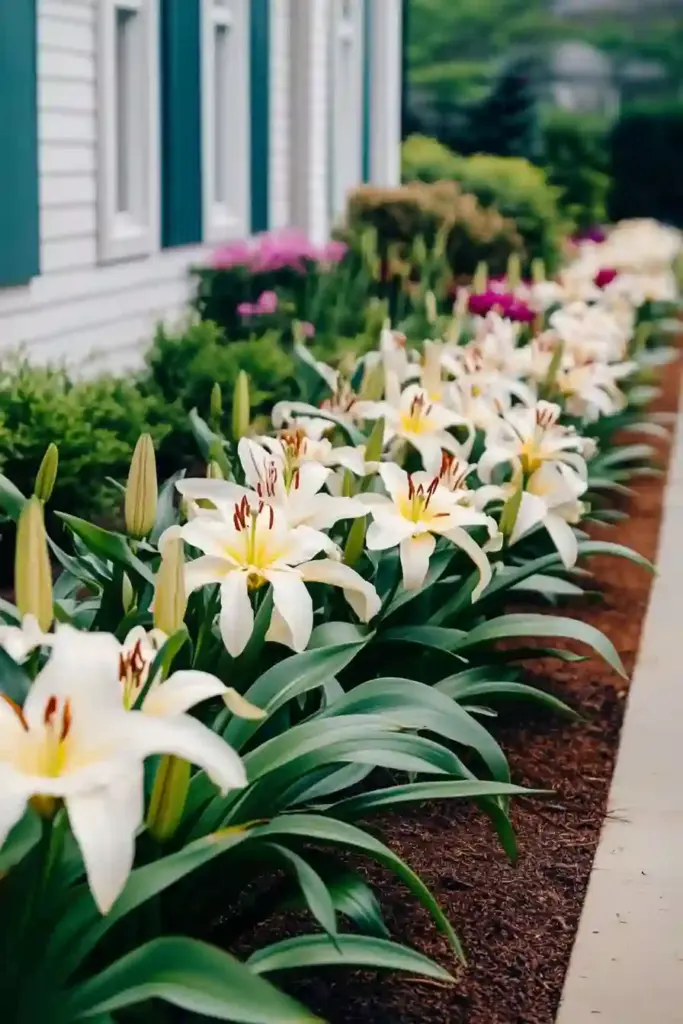
Lilies bring elegance, height, and a dash of drama to any flower bed. With trumpet-like blooms and tall stalks, they’re perfect for back-row plantings or as striking vertical accents near walkways.
Why You’ll Love Lilies:
- Come in bold colors and elegant shapes
- Bloom in summer when other flowers may fade
- Attract bees and butterflies
- Easy to grow in full sun and well-drained soil
Planting Tip:
Stagger lilies among shorter plants for layered interest. Most types prefer full sun but appreciate some afternoon shade in hot climates.
💡 For a breathtaking display, plant Asiatic lilies in groups and pair them with low-growers like alyssum or creeping thyme.
10. Marigolds: Bright, Bold, and Bug-Repelling
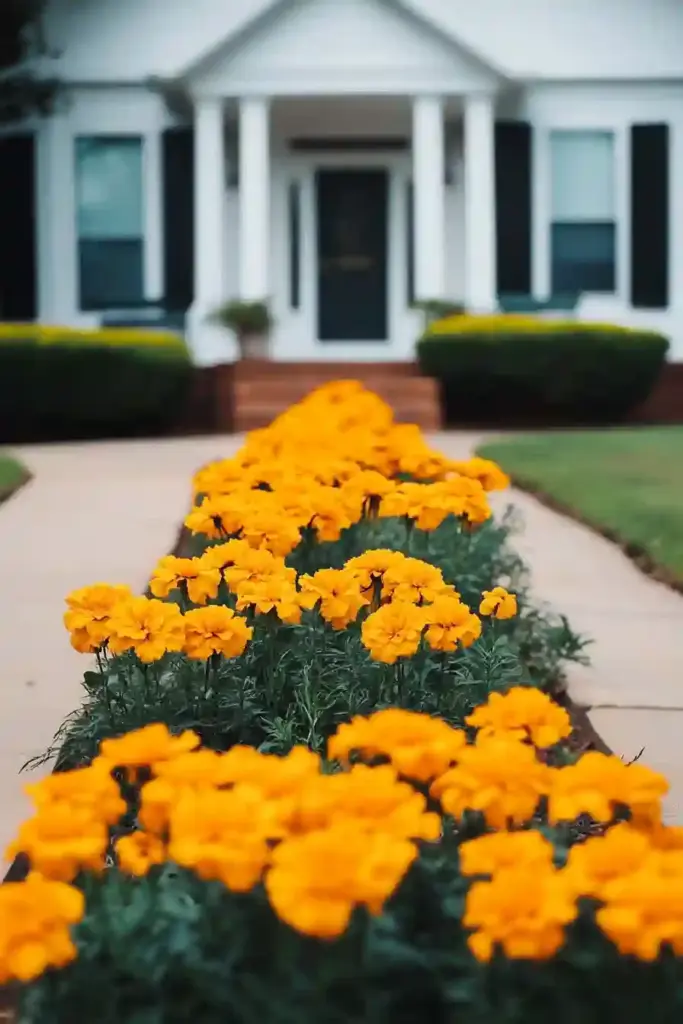
Marigolds are the workhorses of the garden—bright, cheerful, and surprisingly functional. Their rich orange, yellow, and red hues light up any flower bed, while their natural pest-repelling properties help protect nearby plants.
Why Marigolds Are a Smart Pick:
- Extremely easy to grow, even for beginners
- Bloom from spring through fall with minimal fuss
- Deter pests like aphids and nematodes
- Great for borders, pathways, or interplanting with vegetables
Planting Tip:
Plant marigolds in full sun and deadhead regularly to keep blooms coming. For an eye-catching edge, alternate rows of yellow and orange varieties.
💡 Pair marigolds with tomatoes, basil, or peppers if your flower bed borders your veggie garden—it’s a natural win-win.
11. Begonias: Shade-Loving Color Bursts
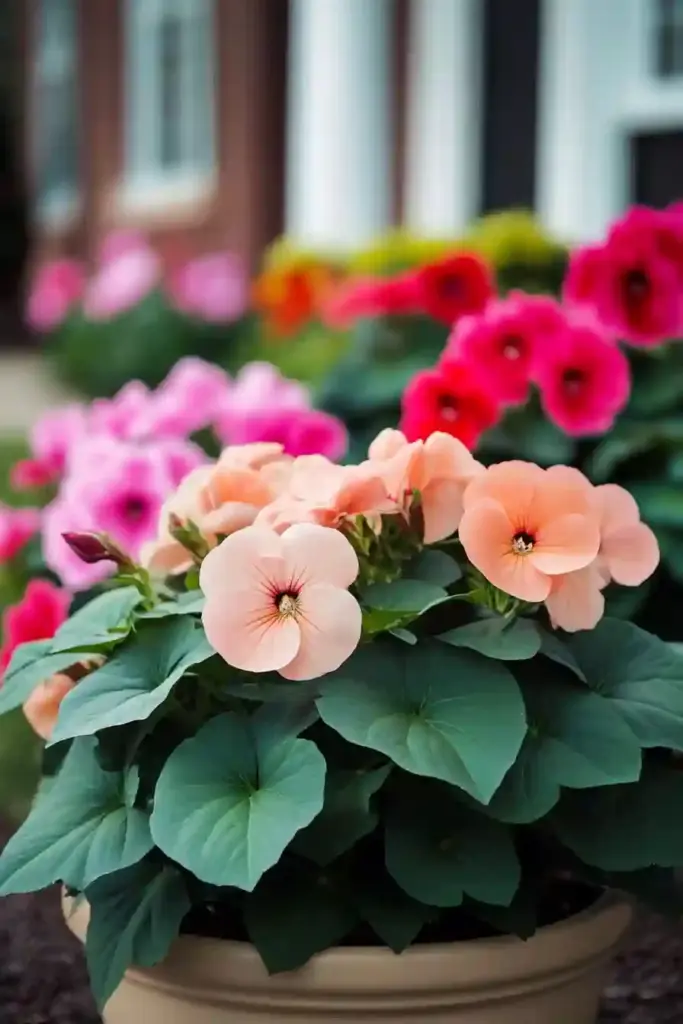
If your front yard leans more shady than sunny, begonias are your best friends. Known for their vibrant blooms and unique foliage, they bring texture and color to areas that other flowers struggle in.
Why Gardeners Adore Begonias:
- Thrive in partial to full shade
- Available in both bright blooms and dramatic foliage
- Low-maintenance with high visual impact
- Perfect for beds, containers, or hanging baskets
Planting Tip:
Keep soil lightly moist and use mulch to help retain water. Begonias love filtered light and don’t like soggy feet—so make sure your flower bed drains well.
💡 Mix fibrous begonias with coleus and impatiens for a lush, tropical feel in shady front yard spots.
12. Petunias: Color All Summer Long
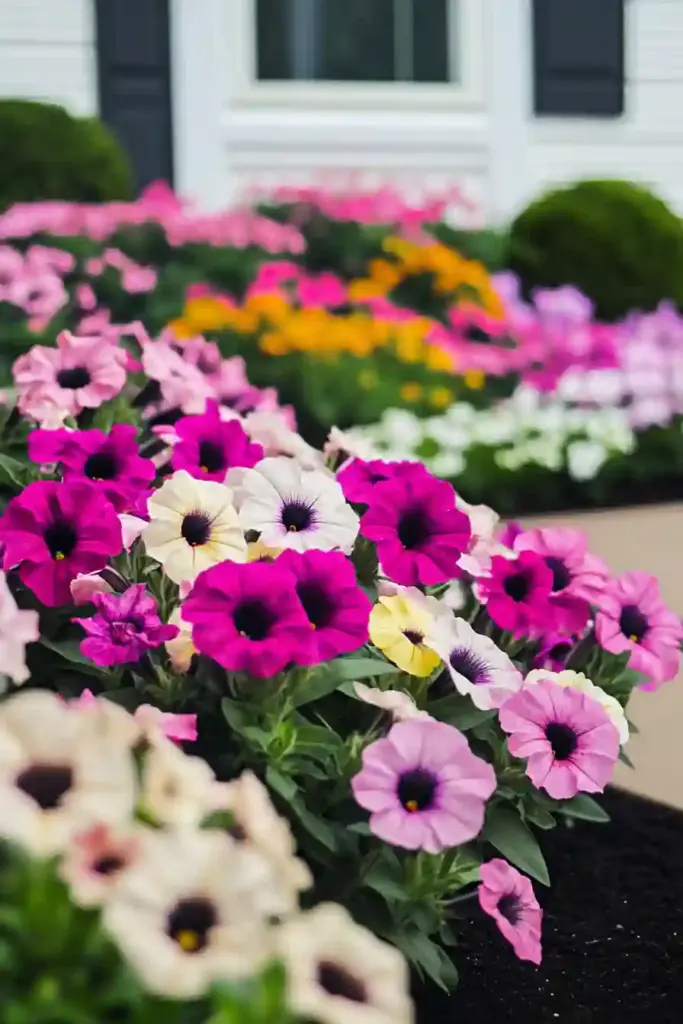
If long-lasting color is your goal, petunias are hard to beat. These vibrant annuals are practically made for flower beds in front of house designs, cascading beautifully over borders and containers.
Why Petunias Are a Front Yard Favorite:
- Bloom non-stop from spring to fall
- Come in every color under the sun (plus stripes and patterns!)
- Attract pollinators and resist heat
- Work well in containers, hanging baskets, or mass plantings
Planting Tip:
Petunias love full sun and rich, well-drained soil. Water regularly, especially in containers, and deadhead often to keep the flowers coming.
💡 For a modern touch, use tall planters with trailing petunias at your entrance—they create instant curb appeal!
13. Zinnias: Bold Blooms That Love the Sun
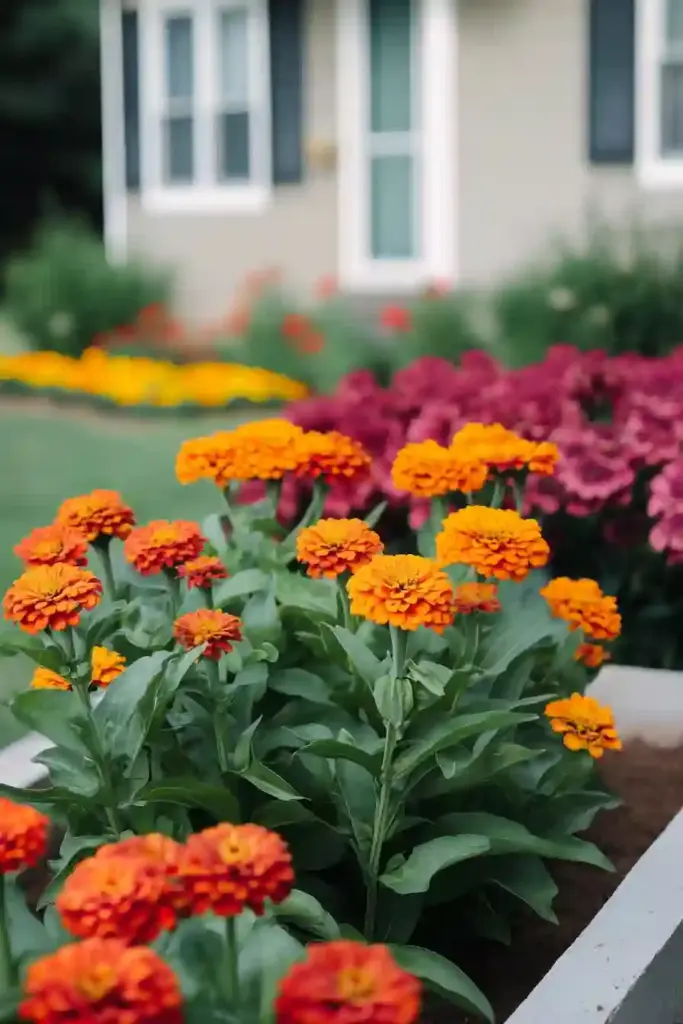
When it comes to color variety and easy care, zinnias are tough to beat. These heat-tolerant annuals bloom in bright, punchy shades and bring a playful energy to any front yard flower bed. Plus, they’re magnets for butterflies!
Why Zinnias Deserve a Spot Out Front:
- Bloom nonstop from early summer to frost
- Thrive in full sun and hot, dry conditions
- Ideal for cut flowers—snip and enjoy indoors
- Come in compact to tall varieties for flexible design
Planting Tip:
Zinnias prefer to be direct-sown into warm soil, so wait until after the last frost. Space plants about 6–12 inches apart for good airflow and fewer disease issues.
💡 Try mixing different zinnia varieties in one bed for a lively, wildflower-style effect that’s pure summer joy.
14. Geraniums: Classic and Colorful Workhorses
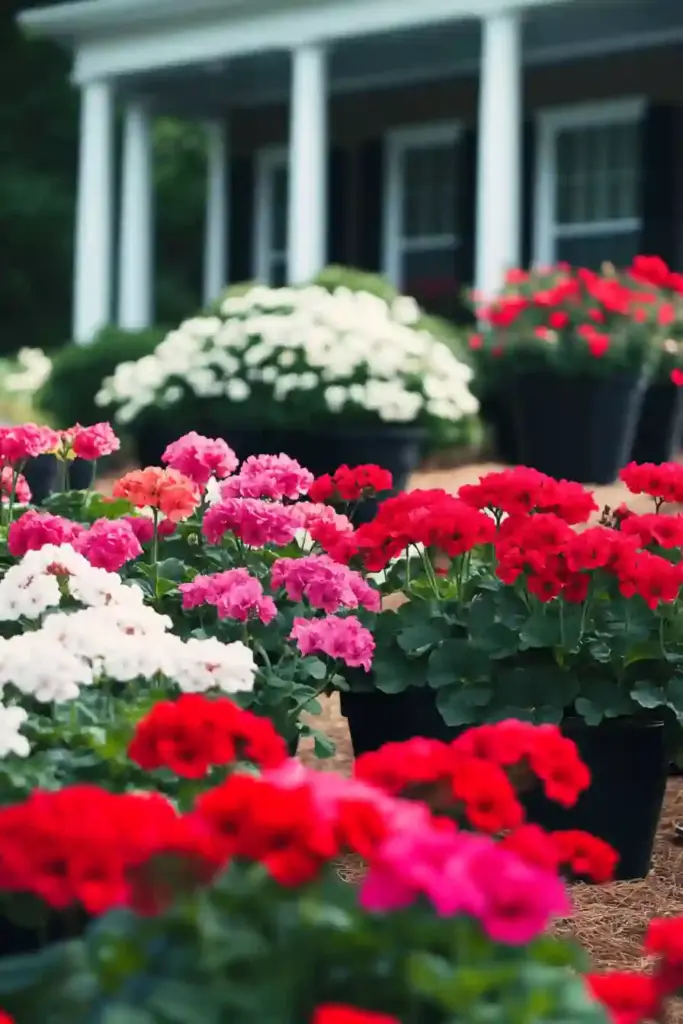
Known for their vivid clusters of blooms and pleasant scent, geraniums are timeless garden favorites. Whether you go with classic red or playful pinks and whites, they bring season-long color and a tidy look to your front beds.
Why You’ll Love Geraniums:
- Tolerant of sun, heat, and less-than-perfect soil
- Available in trailing and upright varieties
- Pair well with evergreens, herbs, or other annuals
- Perfect for edging beds, planters, or window boxes
Planting Tip:
Give geraniums about 8–12 inches of space and water when the top inch of soil feels dry. Remove spent blooms to encourage fresh flowers all season.
💡 Add a few scented-leaf varieties like lemon or rose geraniums near your front porch—they smell amazing and deter pests.
15. Phlox: Sweetly Scented Summer Color
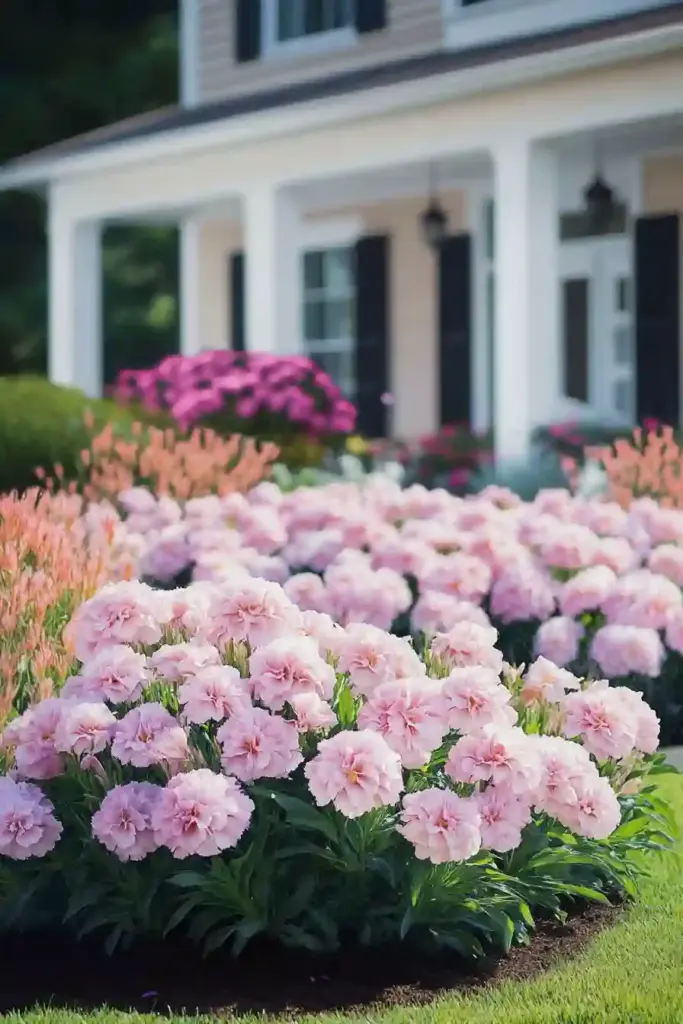
Phlox adds both color and fragrance to your flower beds, making it a charming choice for high-traffic areas like front yards. From creeping ground covers to upright garden phlox, this versatile plant fits beautifully in all kinds of garden designs.
Why Phlox Stands Out:
- Comes in shades of pink, white, purple, and red
- Attracts butterflies and hummingbirds
- Some varieties bloom for months
- Works well as a border, backdrop, or filler
Planting Tip:
Phlox prefers full sun but tolerates light shade. Make sure the soil is rich and drains well—mulch helps retain moisture and reduce weeds.
💡 Use creeping phlox to soften stone pathways or cascade over retaining walls for a romantic, flowing look.
16. Coreopsis: Sunshine in Plant Form
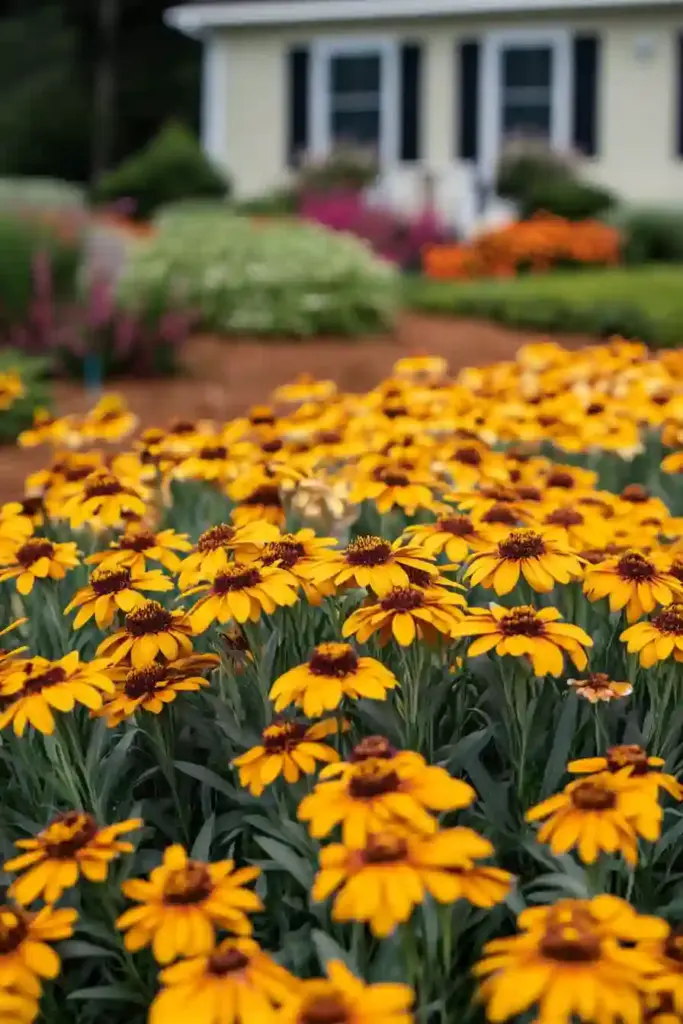
Also known as tickseed, coreopsis brings a burst of cheerful yellow (and sometimes pink or red) to your flower beds. These easy-going perennials are a dream for gardeners who want low-fuss color that lasts from late spring through fall.
Why Coreopsis Makes the Cut:
- Blooms for months with little maintenance
- Tolerates heat, drought, and poor soil
- Attracts butterflies and beneficial insects
- Great for wildflower-style or cottage gardens
Planting Tip:
Coreopsis loves full sun and well-drained soil. Deadheading will extend the bloom period, but some newer varieties are self-cleaning for even less upkeep.
💡 Use coreopsis as a filler between bolder plants like roses or peonies—it’s the ultimate bright backdrop.
17. Sedum: The Sculptural Standout
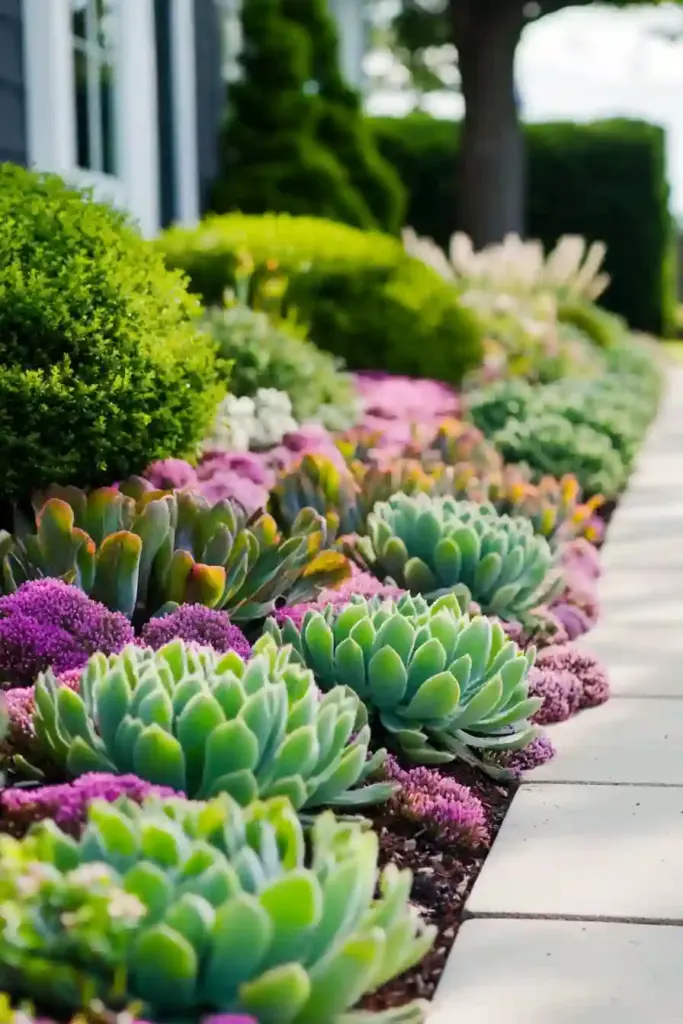
For a modern, structured look with zero stress, sedum is your go-to. Also called “stonecrop,” this succulent-like perennial comes in trailing and upright forms, perfect for edging, containers, or dry spots where other plants struggle.
Why Sedum Is So Versatile:
- Thrives in poor soil and full sun
- Extremely drought-tolerant once established
- Adds texture and structure to your flower beds
- Looks great year-round—even in winter!
Planting Tip:
Sedum doesn’t like soggy soil, so make sure your planting area drains well. Mix different varieties (creeping and upright) for a dynamic, layered effect.
💡 ‘Autumn Joy’ sedum is a favorite for fall color—it turns a gorgeous rosy bronze as the season shifts.
18. Astilbe: Soft, Feathery Texture for Shady Beds
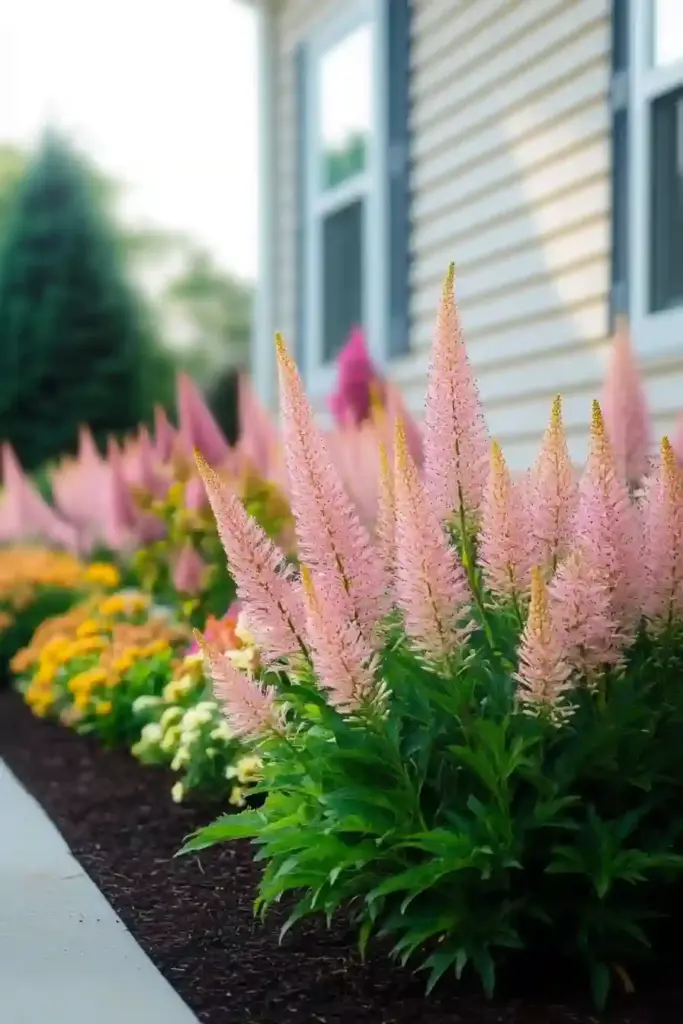
If your front yard is more shaded, astilbe is a fantastic way to add volume, softness, and romantic flair. With its plume-like flowers and ferny foliage, astilbe provides contrast against broad-leafed plants like hostas and hydrangeas.
Why Astilbe Belongs in Your Garden:
- Blooms in pinks, purples, whites, and reds
- Thrives in shade or part-shade spots
- Loves moist soil—great near downspouts or shady corners
- Attracts pollinators while staying deer-resistant
Planting Tip:
Water regularly, especially in dry periods, and mulch well to retain moisture. Group multiple astilbe plants together for a lush, woodland vibe.
💡 Astilbe pairs beautifully with hostas, ferns, and coral bells to create a layered, textured shady oasis.
19. Echinacea: The Pollinator Powerhouse
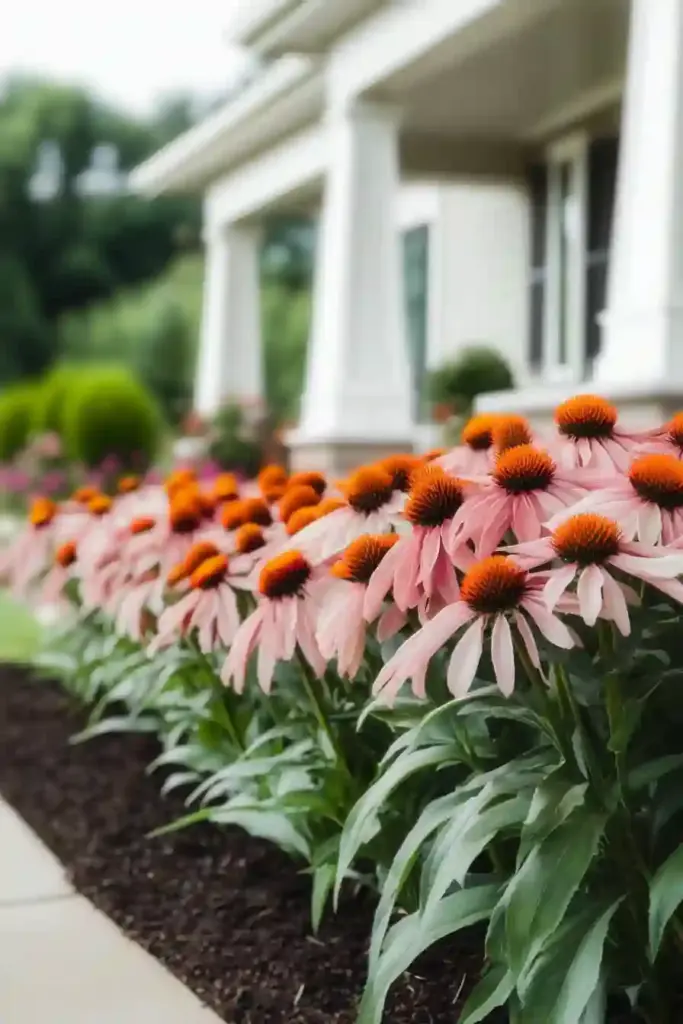
Commonly known as coneflower, echinacea is a standout in any sunny front yard flower bed. With bold pink, purple, or even orange blooms, this tough perennial attracts pollinators while delivering long-lasting summer color.
Why Echinacea is Garden Gold:
- Blooms from mid-summer into fall
- Attracts bees, butterflies, and even goldfinches
- Tolerates drought and poor soil conditions
- Low-maintenance and very hardy
Planting Tip:
Plant echinacea in full sun and space them 18–24 inches apart for airflow and spread. Leave seed heads in place after blooming—they provide winter interest and food for birds.
💡 Pair echinacea with black-eyed Susans, lavender, or ornamental grasses for a native-inspired pollinator paradise.
20. Snapdragons: Vertical Color for Every Season

Snapdragons bring height, drama, and a playful color palette to your front yard beds. With spires of tubular blooms in everything from soft pastels to bold jewel tones, they’re especially great for borders and vertical interest.
Why Snapdragons Snap:
- Great for cool-season planting (early spring or fall)
- Compact or tall varieties to fit any design
- Attract bees and hummingbirds
- Beautiful in cut flower arrangements
Planting Tip:
Snapdragons prefer rich, well-drained soil and cooler weather. Water at the base to avoid mildew and deadhead to encourage reblooming.
💡 Mix tall snapdragons in the back of beds with pansies or violas up front for a color-rich seasonal display.
21. Impatiens: Shady Garden Rockstars
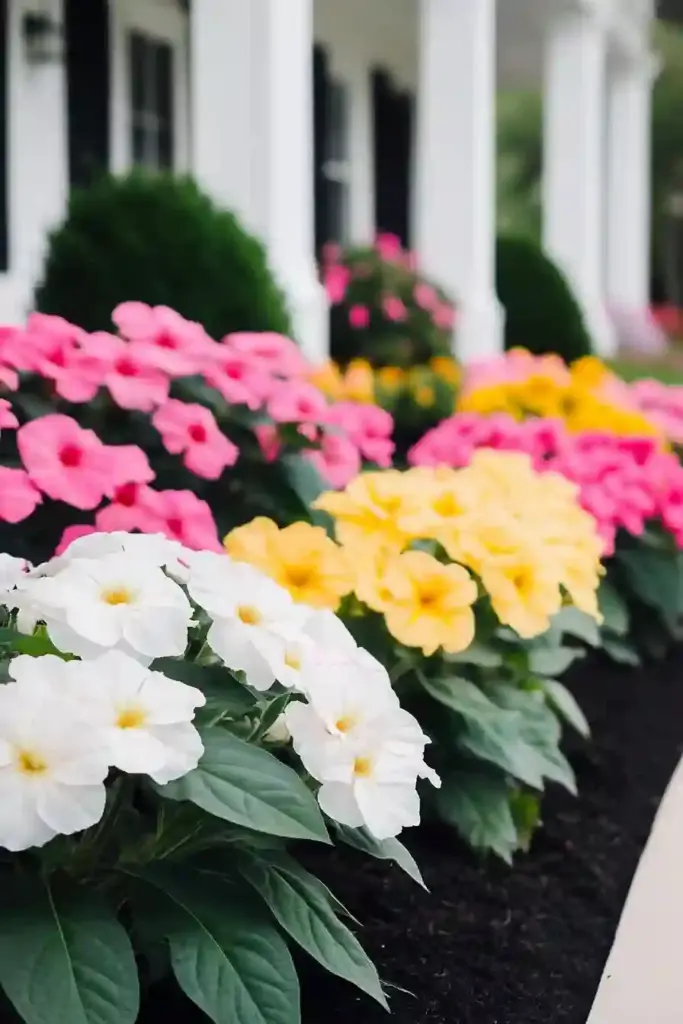
If your front yard is shady and you want vibrant color all season, impatiens are a foolproof solution. These prolific bloomers create a lush carpet of reds, pinks, purples, and whites that instantly brightens any dim corner.
Why Impatiens Work So Well:
- Thrive in shade or filtered light
- Bloom from spring through fall without pause
- Perfect for under trees, along porches, or in containers
- Easy to grow with minimal maintenance
Planting Tip:
Keep soil moist but not soggy, and space plants 6–12 inches apart for full coverage. Mulch helps conserve moisture and keeps roots cool.
💡 Mix different impatiens shades for a vibrant “confetti” effect that adds instant cheer to your front yard.
🌷 Choosing the Right Flowers for Your Front Yard
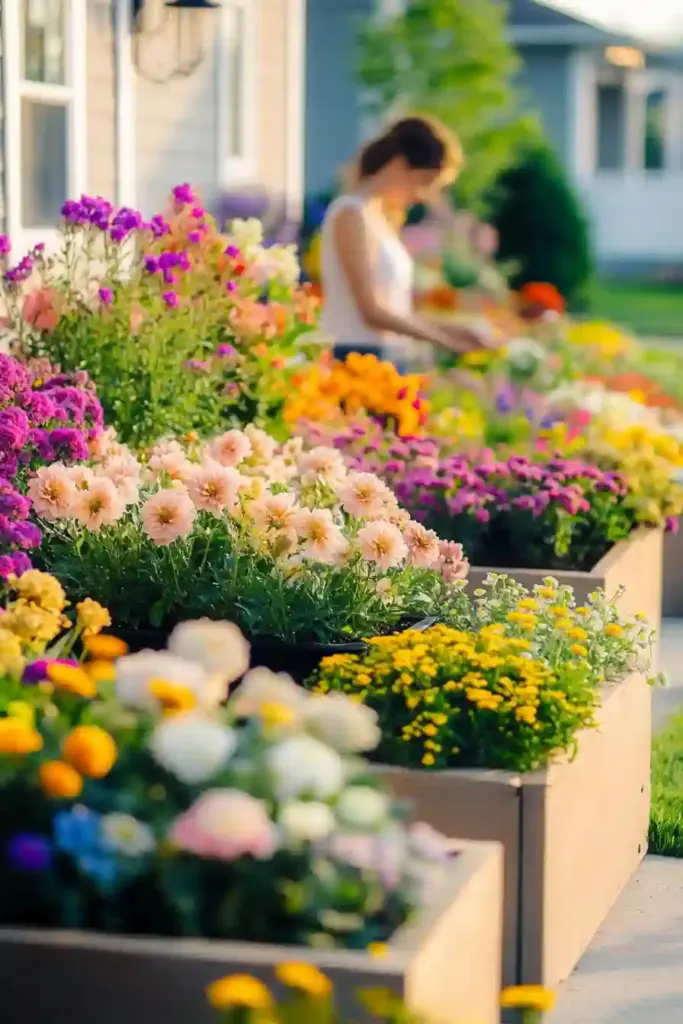
Designing the perfect flower beds in front of house starts with choosing the right blooms for your unique space. Beyond just picking pretty colors, it’s important to think about long-term success—based on your climate, sunlight, and how much time you want to spend on maintenance.
Perennials vs. Annuals
One of the first decisions you’ll make is whether to plant perennials or annuals—or a blend of both.
- Perennials (like echinacea, daylilies, and hostas) return year after year, making them budget-friendly and lower-maintenance in the long run.
- Annuals (like petunias, impatiens, and marigolds) offer vivid seasonal color and flexibility—you can switch up your design every year.
💡 Pro Tip: Combine the two for a layered look—perennials for structure, annuals for bursts of changing color.
Sunlight and Soil Considerations
Before planting, take time to observe your yard. How much sun does it get? What’s your soil type?
- Full Sun (6+ hours): Ideal for zinnias, roses, lavender, coreopsis, and tulips.
- Partial Shade: Perfect for hydrangeas, begonias, and snapdragons.
- Full Shade: Go for impatiens, hostas, or astilbe.
As for soil, test it or take a sample to your local garden center. Many plants thrive in well-drained, loamy soil, but some (like sedum or lavender) prefer it sandy and dry, while others (like astilbe) love more moisture.
🪻 Designing Flower Beds That Pop
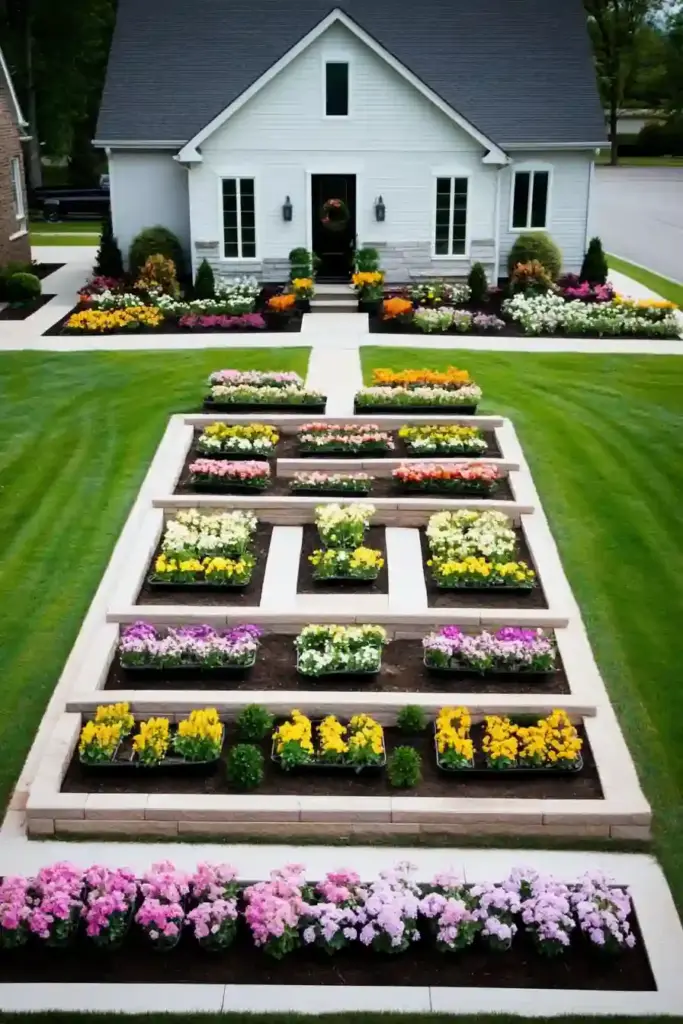
A well-planned flower bed doesn’t just showcase plants—it creates a visual story that draws the eye and elevates your home’s entire look.
Color Schemes & Themes
Think of your flower bed as a canvas and your blooms as the paint.
- Monochromatic: Stick to different shades of the same color for a calming, cohesive look.
- Complementary: Use opposite colors (like purple and yellow) for bold contrast.
- Analogous: Blend colors next to each other on the wheel (like red, orange, and yellow) for a harmonious vibe.
Pick a theme if you want extra cohesion—like a cottage garden, modern minimalist, or pollinator paradise.
Layering and Height Variation
A key trick used by landscape pros is layering your plants by height:
- Back Row: Taller plants like lilies, snapdragons, or hydrangeas
- Middle Layer: Mid-height options like peonies, geraniums, or phlox
- Front Row: Low-growing flowers like marigolds, petunias, or creeping phlox
Add ground covers or mulch to keep the bed tidy and help retain moisture.
💡 Using staggered heights ensures every plant shines—plus it gives your bed that full, lush, professionally-designed look.
🌼 Conclusion: Let Your Flower Beds Do the Talking
Adding well-designed flower beds in front of your house is more than just a visual upgrade—it’s a way to greet your guests with beauty, boost your curb appeal, and enjoy a little slice of nature right outside your door. Whether you lean toward low-maintenance perennials, bold seasonal color, or a little of both, your front yard can bloom into something truly special.
Start small, experiment with combos, and let your personality shine through your planting. You’ll be amazed at the difference flowers can make.

